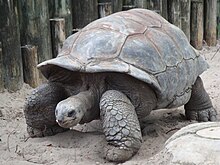Giant tortoises
| Giant tortoise | |
|---|---|
 |
|
| Aldabra giant tortoise | |
| Scientific classification | |
| Kingdom: | Animalia |
| Phylum: | Chordata |
| Class: | Sauropsida |
| Order: | Testudines |
| Suborder: | Cryptodira |
| Family: | Testudinidae |
| Genera | |
Giant tortoises are characteristic reptiles that are currently found on two groups of tropical islands: the Aldabra Atoll in Seychelles and the Galapagos Islands in Ecuador (a population at the Mascarene Islands was exterminated by the 1900s). These tortoises can weigh as much as 417 kg (919 lb) and can grow to be 1.3 m (4 ft 3 in) long. Giant tortoises originally made their way to islands from the mainland; for example, Aldabra Atoll and Mascarenes giant tortoises are related to Madagascar tortoises while Galapagos giant tortoises are related to Ecuador mainland tortoises. This phenomenon of excessive growth is known as islands gigantism or insular gigantism. It occurs when the size of the animals that are isolated on an islands increases dramatically in comparison to their mainland relatives. This is due to several factors such as relaxed predation pressure, competitive release, or as an adaptation to increased environmental fluctuations on islands. However, giant tortoises are no longer considered to have been examples of island gigantism, as they originally evolved their massive sizes on the mainland. Giant tortoises were once common across the Cenozoic faunas of Eurasia, Africa and the Americas.
These animals belong to an ancient group of reptiles, appearing about 250 million years ago. By the Upper Cretaceous, 70 or 80 million years ago, some had already become gigantic. About 1 million years ago tortoises reached the Galápagos Islands. Most of the gigantic species began to disappear about 100,000 years ago. Only 250 years ago there were at least 20 species and subspecies in islands of the Indian Ocean and 14 or 15 subspecies in the Galápagos Islands.
...
Wikipedia
